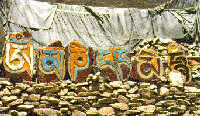 Clay Sculpture
Clay Sculpture
Clay sculptures, also known as "Caca" in Tibetan, are often found in the various statue styles in temples. The larger works can be as tall as five or six meters, while the smallest can fit into a human hand. In addition to various kinds ofBuddhist statues, subjects also include well-known historical figures, such as Songtsan Gambo and Princess Wencheng, as well aspavilions, flowers, insects, fish, birds in flight and animals in motion, wind, clouds, the sun and the moon.
 Stone Carving
Stone Carving
Among the various kinds of Tibetan folk carvings, the most popular isManistone carving due to its vast subject matter and rich contents which have a unique Tibetan hue.
 In Tibet, stone carvings are almost entirely related to religion; "ManiPile," also known as "lection stone" plays an important part in forming this strong religious atmosphere. The "Manipile" is a ubiquitous sight near villages or on Tibetan roadsides. Tibetan Buddhists place small rocks into piles, where each rock is inscribed with the six-word mystic teaching of truth (Om-ma-ni, pad-me-Hum) -- literally "Om! The jewel is in the lotus". A Tibetan will pause at aManipile to pray by walking around it clockwise. The subjects ofManistone carvings are usually lections, Buddhas or Bodhisattvas. According to a carver, the lections or Buddhas on the stone are carved at the request of the relatives of the dead people to release souls from purgatory. Usually, the contents are decided by a Shaman.
In Tibet, stone carvings are almost entirely related to religion; "ManiPile," also known as "lection stone" plays an important part in forming this strong religious atmosphere. The "Manipile" is a ubiquitous sight near villages or on Tibetan roadsides. Tibetan Buddhists place small rocks into piles, where each rock is inscribed with the six-word mystic teaching of truth (Om-ma-ni, pad-me-Hum) -- literally "Om! The jewel is in the lotus". A Tibetan will pause at aManipile to pray by walking around it clockwise. The subjects ofManistone carvings are usually lections, Buddhas or Bodhisattvas. According to a carver, the lections or Buddhas on the stone are carved at the request of the relatives of the dead people to release souls from purgatory. Usually, the contents are decided by a Shaman.
Manistone carving differs significantly from place to place in Tibet according to the demand, interest and materials.Manistone carvings in western Tibet take on an elegant flavor, while those in eastern Tibet have an air of antiquity.
